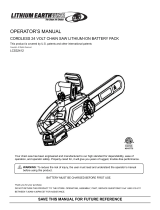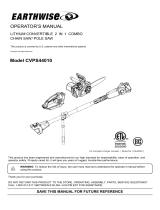ADVERTENCIAS DE SEGURIDAD GENERALES PARA LA HERRAMIENTAS ELÉCTRICAS
2
Modelo CVPS43010
ADVERTENCIAS DE SEGURIDAD IMPORTANTES
ADVERTENCIA: Lea todas las advertencias de seguridad y las
instrucciones. La inobservancia de las advertencias e instrucciones
puede causar descargas eléctricas, incendios o lesiones graves.
Guarde todas las advertencias e instrucciones para consultarlas
en el futuro. El término “herramienta eléctrica” en las advertencias se
refiere a las herramientas eléctricas que funcionan con corriente (con
cordón) o las que funcionan con batería (inalámbricas).
Área de trabajo
• Mantenga limpia y bien iluminada el área de trabajo. Un área
de trabajo mal despejada o mal iluminada propicia accidentes.
• No utilice herramientas motorizadas en atmósferas
explosivas, como las existentes alrededor de líquidos, gases
y polvos inflamables. Las herramientas eléctricas generan
chispas que pueden encender el polvo y los vapores inflamables.
• Mantenga alejados a los niños y circunstantes al maniobrar
una herramienta eléctrica. Toda distracción puede causar la
pérdida del control de la herramienta.
Seguridad eléctrica
• Las clavijas de las herramientas eléctricas deben
corresponder a las tomas de corriente donde se conectan.
Nunca modifique la clavija de ninguna forma. No utilice
ninguna clavija adaptadora con herramientas eléctricas
dotadas de contacto a tierra. Conectando las clavijas originales
en las tomas de corriente donde corresponden se disminuye el
riesgo de una descarga eléctrica.
• Evite el contacto del cuerpo con las superficies de objetos
conectados a tierra, como las tuberías, radiadores, estufas y
refrigeradores. Existe un mayor riesgo de descargas eléctricas
si el cuerpo está haciendo tierra.
• No exponga las herramientas eléctricas a la lluvia ni a
condiciones de humedad. La introducción de agua en una
herramienta eléctrica aumenta el riesgo de descargas eléctricas.
• No maltrate el cordón eléctrico. Nunca utilice el cordón para
trasladar, desconectar o tirar de la herramienta eléctrica.
Mantenga el cordón lejos del calor, aceite, bordes afilados y
piezas móviles. Los cordones eléctricos dañados o enredados
aumentan el riesgo de descargas eléctricas.
• Al utilizar una herramienta eléctrica a la intemperie, use un
cordón de extensión apropiado para el exterior. Usando un
cordón adecuado para el exterior se disminuye el riesgo de
descargas eléctricas.
• Si debe operar una herramienta en lugares húmedos, use un
suministro protegido por un interruptor de circuito con pé-
rdida a tierra (GFCI). El uso de un GFCI reduce el riesgo de
descargas eléctricas.
Seguridad personal
• Permanezca alerta, preste atención a lo que esté haciendo y
aplique el sentido común al utilizar herramientas
eléctricas. No utilice la herramienta eléctrica si está
cansado o se encuentra bajo los efectos de alguna droga,
alcohol o medicamento. Un momento de inatención al utilizar
una herramienta eléctrica puede causar lesiones corporales
serias.
• Utilice protección el equipo otros. Siempre póngase
protección ocular. El uso de equipo protector como mascarilla
para el polvo, calzado de seguridad, casco y protección para los
oídos en las circunstancias donde corresponda disminuye el
riesgo de lesiones.
• Evite que la herramienta se active accidentalmente.
Asegúrese de que el interruptor esté en la posición de
apagado antes de conectar la herramienta a un suministro
de corriente o de colocar un paquete de baterías.
Transportar herramientas eléctricas con el dedo en el
interruptor o enchufar herramientas eléctricas que tienen el
interruptor encendido puede ocasionar accidentes.
• Retire toda llave o herramienta de ajuste antes de encender
la herramienta eléctrica. Toda llave o herramienta de ajuste
dejada en una pieza giratoria de la herramienta eléctrica puede
causar lesiones.
• No estire el cuerpo para alcanzar mayor distancia.
Mantenga una postura firme y buen equilibrio en todo
momento. De esta manera se logra un mejor control de la
herramienta eléctrica en situaciones inesperadas.
• Vístase adecuadamente. No vista ropas holgadas ni joyas.
Mantenga el cabello, la ropa y los guantes alejados de las
piezas móviles. Las ropas holgadas y las joyas, así como el
cabello largo, pueden engancharse en las piezas móviles.
• Si se suministran dispositivos para conectar mangueras de
extracción y captación de polvo, asegúrese de que éstas
estén bien conectadas y se usen correctamente. El uso de la
captación de polvo puede reducir los peligros relacionados con
éste.
Empleo y cuidado de la herramienta eléctrica
• No fuerce la herramienta eléctrica. Utilice la herramienta
eléctrica adecuada para cada trabajo. La herramienta eléctrica
adecuada efectúa mejor y de manera más segura el trabajo, si
además se maneja a la velocidad para la que está diseñada.
• No utilice la herramienta si el interruptor no enciende o no
apaga. Cualquier herramienta eléctrica que no pueda
controlarse con el interruptor es peligrosa y debe repararse.
• Desconecte la clavija del suministro de corriente o retire el
paquete de baterías de la herramienta eléctrica, según sea
el caso, antes de efectuarle cualquier ajuste, cambiarle
accesorios o guardarla. Tales medidas preventivas de
seguridad reducen el riesgo de poner en marcha
accidentalmente la herramienta.
• Guarde las herramientas eléctricas desocupadas fuera del
alcance de los niños y no permita que las utilicen personas
no familiarizadas con las mismas o con estas instrucciones.
Las herramientas eléctricas son peligrosas en manos de
personas no capacitadas en el uso de las mismas.
• Preste servicio a las herramientas eléctricas. Revise para
ver si hay desalineación o atoramiento de piezas móviles,
ruptura de piezas o cualquier otra condición que pueda
afectar el funcionamiento de la herramienta. Si está dañada
la herramienta eléctrica, permita que la reparen antes de
usarla. Numerosos accidentes son causados por herramientas
eléctricas mal cuidadas.
• Mantenga las herramientas de corte afiladas y limpias. Las
herramientas de corte bien cuidadas y con bordes bien afilados,
tienen menos probabilidad de atascarse en la pieza de trabajo y
son más fáciles de controlar.




























